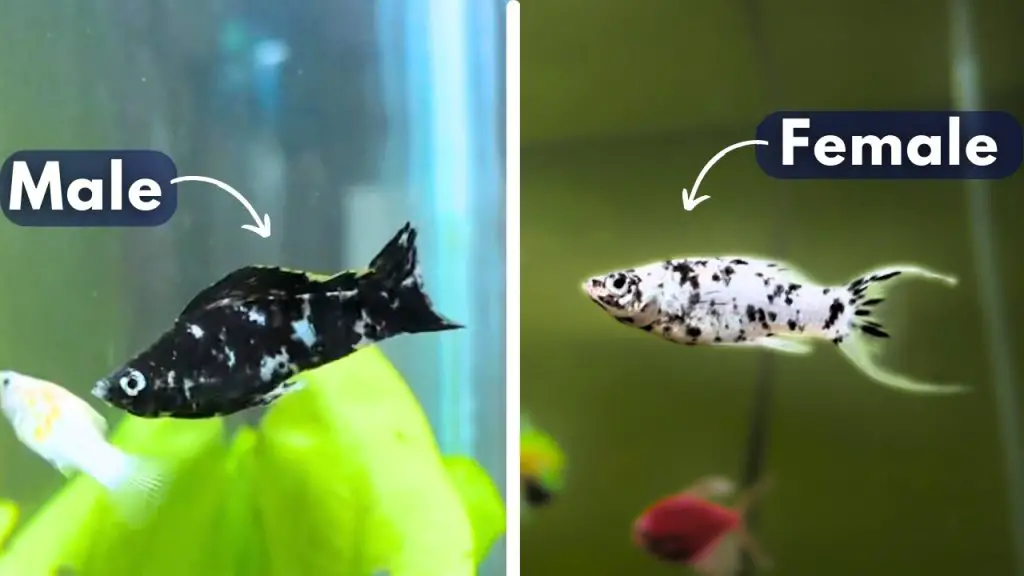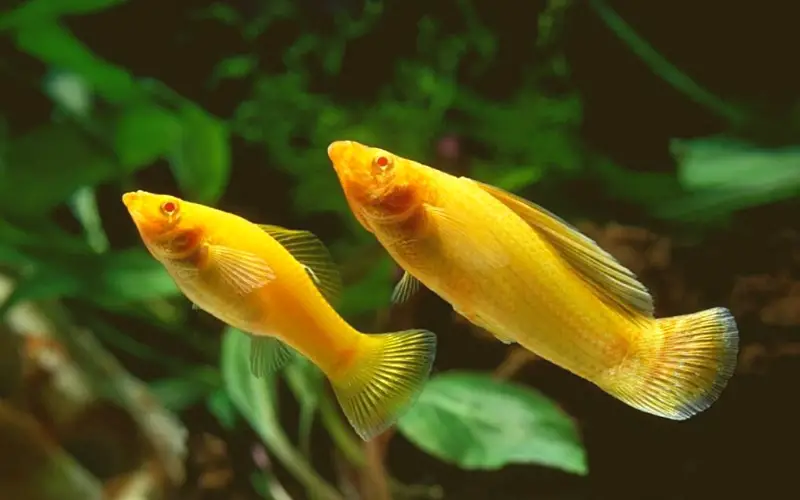Dalmatian molly male vs female: Dalmatian mollies are a popular choice for many fish enthusiasts due to their striking spots and variety of colors. However, determining the gender of these tropical fish can be tricky for someone new to the world of aquarium keeping.
If you’re a fish enthusiast exploring the fascinating world of Dalmatian mollies, understanding the distinction between males and females is crucial. Whether you’re a first-time aquarist or an experienced hobbyist, identifying these differences helps you maintain a balanced tank and manage breeding.
When distinguishing between male and female Dalmatian mollies, one notable difference is their anal fin. Female mollies feature a beautiful fan-shaped or heart-shaped anal fin, while males have a pointed one.
Additionally, if you’re not looking to deal with countless fry, it’s best to avoid adding a male to your tank, as their presence will likely lead to breeding.

In this post, we’ll dive into the intriguing characteristics of male vs female dalmatian molly, highlighting their unique physical traits and behaviors to guide you in selecting or caring for these charming fish.
Male and female Dalmatian mollies have several differences that set them apart, and identifying these differences can be important for breeding or simply for maintaining a happy and healthy community tank.
Dive into the rest of this article to explore more tips on caring for Dalmatian mollies, ensuring a vibrant and healthy aquarium experience.
Table of Contents
ToggleHow to Tell the Difference Between Male & Female Molly Fish?
A few physical characteristics can distinguish male and female molly fish. Male molly fish generally tend to be slimmer and have a more streamlined body shape than females.
Additionally, male molly fish often have a gonopodium, which is a modified anal fin that resembles a stick-like projection. This gonopodium is used for mating and can be observed by carefully examining the fish’s underside.

On the other hand, female molly fish have a more rounded abdomen and lack the elongated gonopodium. Another way to tell the difference is by examining the anal fin of the fish. In males, the anal fin is pointed and elongated, while in females it is more rounded.
By carefully observing these physical characteristics, fish keepers can easily determine the gender of their molly fish. It’s important to note that these differences may not be as noticeable in young or juvenile molly fish, so it’s best to wait until they have matured before attempting to discern their gender.
5 Clear Differences Between Dalmatian Molly Male Vs Female
Dalmatian mollies are popular aquarium fish known for their vibrant black and white spotted patterns. However, distinguishing males from females can be tricky for beginners. Here are five clear Dalmatian molly fish male vs female differences to help you tell them apart:
1. Anal Fin:
This is the most reliable and readily visible indicator.
- Male: The anal fin is pointed and extends back towards the tail like a gonopodium. It’s used for internal fertilization.
- Female: The anal fin is rounded and resembles the other fins, not extending towards the caudal fins.
2. Body Shape:
- Male: Generally grows larger with a more torpedo-shaped body.
- Female: Fuller and rounder, especially in the abdomen, as they carry eggs.
3. Dorsal Fin:
- Males Often have larger dorsal fins than females.
- Female: Smaller and more rounded.
4. Coloration:
- Male: Colors tend to be brighter and more vivid, especially during breeding season.
- Female: Colors are generally duller and less intense.
5. Behavior:
- Male: More active and often chases and harasses females, especially during breeding season. They may display aggressive behavior towards other males.
- Female: More passive and spend time exploring the tank or hiding.
Additional Tips:
- Observe the fish from the side for a clearer view of the anal fin and body shape.
- Compare multiple fish of similar age for a better understanding of the differences.
- Consider purchasing a group of young mollies, as they will naturally develop their adult characteristics over time, making sex easier.
These are general guidelines, and some individual fish may vary slightly. However, by focusing on these fundamental differences, you should be able to sex your Dalmatian mollies with confidence accurately.
Commonly Asked Questions about female vs male dalmatian mollies fish (FAQs)
How can you tell if a Dalmatian molly is male or female?
To identify male vs female dalmatian molly, Spot the fin! Male Dalmatian mollies have a pointed anal fin, while females have a rounded one. Both sexes have beautiful spotted patterns, but only males sport a showy dorsal fin.
How can you tell how old a molly fish is?
What is the age of molly fish? Pinpointing the age of a molly fish (Poecilia sphenops) is tricky! While size can offer clues (younger = smaller), it’s unreliable due to varied growth rates. Observing breeding behavior (males only) and fin development (males grow a showy dorsal fin) can suggest maturity but not exact age. Unfortunately, accurate aging for mollies remains elusive.
Is it OK to have all male mollies?
Keeping all male mollies isn’t ideal. While it may seem peaceful initially, their inherent competitiveness can lead to fin nipping and stress. A balanced female-to-male ratio (around two females for every male) is recommended for a thriving molly community. This promotes natural behavior and reduces aggression.
Why is my male molly chasing the female?
Male mollies may chase females during mating behavior. This pursuit is often a part of their natural reproductive instincts, as males try to court and mate with receptive females.
How long does it take a molly to grow full size?
Mollies reach adult size (3-5 inches) around four months, but growth can continue beyond that. Watch for the telltale signs: males develop a showy dorsal fin, while both sexes stop growing significantly.
What is the male molly mating behavior?
Male mollies turn on the charm! They display their vibrant fins, chase females playfully, and even nip their bellies to initiate mating. Watch for the flashy dorsal fin, a sure sign he’s ready to impress.
Can you keep male and female molly fish together?
Yes, keeping male and female molly fish together is common in aquariums. However, be prepared for potential breeding and consider the appropriate tank conditions to accommodate fry if reproduction occurs.
How can you tell if a molly fish is pregnant?
Bump watch! A pregnant molly’s belly swells, especially near the dark gravid spot. Look for increased appetite, hiding, and sudden warmth-seeking behavior. Bonus: Males might even chase her playfully!
Can molly fish store sperm?
Yes, molly fish females can store sperm! This nifty trick, called internal fertilization, allows them to fertilize eggs and have multiple fry batches even after months of separation from a male. It’s like having a built-in sperm bank!
Is female mollies larger than males?
Not typically! Male mollies often grow slightly larger than females, reaching up to 5 inches compared to females’ average of 3-4 inches. However, size can vary depending on the species and individual factors, so it’s not a foolproof way to sex your mollies.
Conclusion
So, how to identify dalmatian molly fish male vs. female? In conclusion, understanding the differences between male and female Dalmatian Molly fish is crucial for any aquarium enthusiast. While both sexes possess unique characteristics, such as the vibrant colors of the males and the gravid spots of the females, it’s essential to consider their compatibility, behavior, and breeding habits when creating a harmonious tank environment. By grasping these Dalmatian molly male vs female distinctions, you can ensure the optimal well-being and reproduction of your Dalmatian Molly population. So, whether you’re a seasoned aquarist or a beginner, remember to delve into the intriguing world of Dalmatian Molly fish, exploring the fascinating contrasts between male and female counterparts.
You might also like
- Male Vs Female Molly Fish: 6 Ways to Identify Mollies Gender
- Dalmatian Balloon Molly: Care, Size & Food (Ultimate Guide)
- 7 Signs of a Pregnant Dalmatian Molly & What to Do Instantly
- Dalmatian Balloon Molly: Care, Size & Food (Ultimate Guide)
- Dalmatian Lyretail Molly Care: (Size, Tankmates & Best Diet)
- Dalmatian Mollies Fish: Expert’s Care & (7 Beginner’s Tips)




